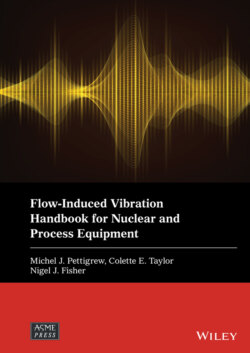Читать книгу Flow-Induced Vibration Handbook for Nuclear and Process Equipment - Группа авторов - Страница 54
2.6.3 Wear Depth Calculations
ОглавлениеTo be conservative, it may be assumed that fretting‐wear is taking place continuously for a total time, T, corresponding to the life of the component and equal to half the life of the station, Ts. Thus, T = 0.5Ts and the total fretting‐wear volume, V, is then calculated from Eq. (2-53):
(2‐53)
The resulting tube wall wear depth, dw, can be calculated from the wear volume. This calculation requires the relationship between dw and V. For example, for a tube within a circular hole or a scalloped bar, it may be assumed that the wear is taking place uniformly over the thickness, L, and half the circumference, D, of the support. Thus:
(2‐54a)
Alternately, for lattice bars and for flat bars, it may be assumed that wear is taking place only on the tubes. Thus, the bars and the wear scars remain flat. For lattice bars in the straight‐leg section, wear occurs on both sides of the tube and M = 4 in Eq. (2-54b); for flat bars in the U‐bend, we assume that wear occurs on one side of the tube and M = 8 in Eq. (2-54b). This geometry leads to
(2‐54b)
where
(2‐54c)
Thus, the tube wall fretting‐wear depth, dw, may be estimated using Eqs. (2-53) and either (2-54a), or (2-54b) and (2-54c).
